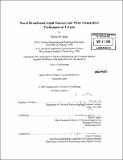Novel broadband light sources and pulse generation techniques at 1.5 [mu]m
Author(s)
Shen, Hanfei M, 1979-
DownloadFull printable version (25.61Mb)
Other Contributors
Massachusetts Institute of Technology. Dept. of Electrical Engineering and Computer Science.
Advisor
Erich P. Ippen.
Terms of use
Metadata
Show full item recordAbstract
A wide diversity of applications, in both fundamental science and practical technology, has come to rely on broadband optical light sources as key enabling tools. In this thesis, we investigate three devices that contribute to the generation of broadband light at 1.5 [mu]m. The first two fall into the same broader class of saturable absorber mirrors - one device was developed for low-repetition-rate sub-100-fs ultrafast lasers and the other for high-repetition- rate femtosecond lasers. The third device bypasses generating broadband light directly from a laser altogether through the use of extra-cavity spectral broadening in a novel highly nonlinear glass fiber. In the first category, ultra-broadband saturable absorber mirrors based on III/V and Si material systems were developed for ultrafast lasers. The III/V-based mirrors were designed, fabricated, characterized and implemented in a wide range of wavelengths, spanning the visible to the near-infrared. These mirrors exhibited high-reflectivity ranges of >300 nm. Implementation of these mirrors in Ti:sapphire, Cr4+:forsterite, Cr4+:YAG, and erbium-doped bismuth-oxide lasers demonstrated self-starting and stable modelocked operation. Saturable absorber mirrors were also developed for high-repetition-rate short-cavity femtosecond lasers, with modulation depths ranging from 1.7% to 11%. Post-growth proton bombardment was used to improve recovery times, and preliminary laser testing has yielded promising results, with all structures demonstrating modelocking in an erbium-doped fiber laser. (cont.) Saturable absorber mirrors with integrated dispersion compensation were also designed with 750 fs2 of anomalous group delay dispersion at 1.5 [mu]m. Finally, a novel highly nonlinear bismuth-oxide glass fiber was used to generate smooth, controlled supercontinuum spanning 1200 to 1800 nm. With a 2-cm length and a grating pair for dispersion compensation, compression of 150-fs pulses down to 25-fs was also demonstrated.
Description
Thesis (Ph. D.)--Massachusetts Institute of Technology, Dept. of Electrical Engineering and Computer Science, 2009. In title on title page, [mu] appear as lower case Greek letter. Cataloged from PDF version of thesis. Includes bibliographical references.
Date issued
2009Department
Massachusetts Institute of Technology. Department of Electrical Engineering and Computer SciencePublisher
Massachusetts Institute of Technology
Keywords
Electrical Engineering and Computer Science.